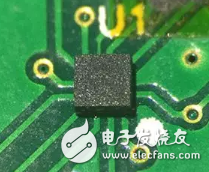At the 2018 Consumer Electronics Show (CES) in Las Vegas, one of the world's largest electronics exhibitions, TDK and AKM unveiled a high-precision 3-axis magnetometer at their respective booths. This groundbreaking sensor represents a significant advancement in magnetic sensing technology, combining cutting-edge components to deliver exceptional performance in a compact form.
The magnetometer integrates TDK’s highly sensitive tunneling magnetoresistive (TMR) components with AKM’s advanced electronic compass ASIC into a small LGA 11-pin package. The resulting device is just 1.6 mm x 1.6 mm x 0.6 mm in size, yet it offers industry-leading performance with an RMS noise level as low as 40 nT-rms and an output data rate of 100 Hz. It also consumes only 40 μA, making it ideal for power-sensitive applications.

Thanks to its high sensitivity of 10 nT/LSB, this magnetic sensor can detect even the smallest changes in the magnetic field with remarkable accuracy. This makes it perfect for applications that require precise position and orientation detection, such as using the Earth’s magnetic field or external magnetic sources. Its versatility allows it to be used in a wide range of devices, including smartphones, tablets, game controllers, wearables, and more. It also supports emerging technologies like VR, AR, MR, and indoor navigation systems where high precision is essential.
Magnetic sensors are essential tools that detect and measure magnetic fields, converting them into electrical signals. These sensors play a crucial role in various industries, from automotive and industrial automation to healthcare and consumer electronics. They are used to measure the strength, direction, and movement of magnetic fields, enabling a wide range of applications from simple position sensing to complex navigation systems.
As technology continues to evolve, there is a growing demand for smaller, more sensitive, and energy-efficient magnetic sensors. Traditional magnetic sensors based on electromagnetic induction or Hall effect are being gradually replaced by more advanced solutions like magnetoresistive sensors, which offer higher sensitivity, lower power consumption, and better integration capabilities.
Among these, TMR (Tunnel Magnetoresistive) sensors stand out due to their superior performance. They are widely used in hard disk drives and magnetic memory applications, with major manufacturers such as Seagate, WD, and TDK leading the way. AMR-based sensors are also popular, with companies like Honeywell and NEC offering reliable solutions. Meanwhile, GMR and spin-valve sensors are gaining traction, though they are still in limited production.
Despite the global advancements in TMR technology, its development and production remain concentrated in a few key players. The manufacturing process involves sophisticated nanofilm and nano-scale electronic component techniques, requiring specialized equipment and expertise. As a result, many magnetic sensor manufacturers lack the necessary experience and resources to develop TMR chips independently.
Globally, only a handful of companies, such as NVE and Micro MagneTIcs in the U.S., have the capability to produce TMR magnetic sensor chips in small quantities. In contrast, domestic markets face challenges due to limitations in technology, equipment, and skilled personnel, leaving a gap in the TMR sensor market.
Battery connector,battery holder,battery holder spring,power connector,connector
Dongguan Yiyou Electronic Technology Co., Ltd. , https://www.dsubminiature.com